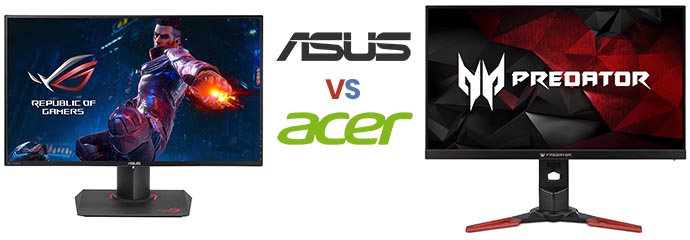I’m a frequent monitor upgrader.
I love taking advantage of fast refresh rates, high resolutions, and technology such as adaptive sync as they become available.
I’ve owned and installed more monitors than I can count.
Here I’ll look at two of my favorite monitor brands: ASUS and Acer – and detail which will be the better choice for you.
Quality
To start with, the most important component of a monitor is the display panel itself.
There are only a few manufacturers making panels for brands like ASUS and Acer.
For example, you’ll see a number of different brands with 165Hz 1440p displays, but the same OEM’s factory makes each of them.
If you choose a good panel, the image produced will be very similar between brands. Same goes for the quality and longevity of the screen.
The parts used for the bezel, buttons, stand, and circuitry are what differ.
In most comparable models, ASUS makes bezels and stands that look and feel a bit higher quality.
Build quality, or how well the monitors are assembled, has not been a problem with either brand among the many monitors I’ve installed.
Quality control matters for avoiding the frustration of a defective display out of the box. Both ASUS and Acer seem to do as well as can be expected given the variation between panels.
Value
Acer is the clear value winner. I’ve purchased more Acer monitors for myself than any other brand due to the price vs. performance they offer.
Keep in mind that ASUS and Acer often share the same display panels between similar models. You may see as big as a $100 difference between brands – this despite the specs and image quality being the same.
If you’re looking to squeeze a better monitor into your budget, I don’t hesitate to recommend Acer.
That said, ASUS offers a good value and prices their displays similarly to brands like Dell and LG.
Features
Many monitors share the same panels, but nearly everything else is unique to the brand you choose.
Overall, I think ASUS has a better feature set between similar models.
Software & Interface
ASUS has some of the best user interfaces on their monitors.
The OSD, or On Screen Display, is well laid out and easy to navigate on all recent ASUS models I’ve used.
Acer seems to like to reinvent the wheel with each model. From varying their buttons to changing menu layouts, there isn’t a lot of consistency. Acer’s menus are gradually improving, but the info just isn’t as well laid out.
ASUS goes a step further and offers software to install called DisplayWidget.
You can make quick changes to brightness, contrast, and color using slider bars. I find this more convenient to do with the mouse than with buttons on the monitor.
App Sync is another great feature of DisplayWidget. You can customize display settings based on the app you launch. Perhaps you like to lower the brightness when watching movies, or to increase the saturation when you’re playing a particular game. This is easy to automate with a few clicks.
Though these changes are possible with 3rd party software, it’s handy that ASUS includes all these options in one place.
Ports
Not too long ago, Acer was stingy with ports on many models, including the otherwise excellent XB270HU. They’ve since wised up.
Both ASUS and Acer include both DisplayPort and HDMI on nearly every model. DVI-D is also found on lower-end models.
G-Sync & Freesync
I won’t get into which adaptive sync technology to choose, but you’ve probably already got that part figured out.
These technologies don’t vary between brands. That is, G-Sync on an ASUS monitor will work just as it does on Acer.
Both brands have a wide array of models with or without G-Sync and Freesync. You’ll simply need to narrow down based on which adaptive sync type you plan to use, if any.
Stands
I personally love monitor arms for the space they free up on the desk and huge adjustment range. I use my monitors’ built-in VESA mounts and my stands never see the light of day.
If you’re not using an arm, it’s important to compare stands between brands. Some offer limited or no height adjustment. That’s no good for ergonomics.
All of ASUS’s gaming monitors (aside from the VA325H/VA326H) have stands with full height and tilt adjustment. Some of the <$200 monitors from both brands lack height adjustment, so be sure to check the specs.
Above ~$200 or so, I think ASUS stands have a high quality look and feel. With Acer, the Predator line’s stands are well done. Outside of these ranges, give the stands a close look if the appearance and adjustments matter to you.
Warranty
Monitors are often a significant investment. The last thing you want is a dead, out of warranty display.
ASUS and Acer both have good policies, but with some differences.
Most importantly, they both have a 3-year parts and labor warranty.
You should know that some other major brands like Samsung, MSI, and Viewsonic only have a 1-year warranty. I avoid purchasing those brands due to the short warranty duration.
The 3-year warranties from both ASUS and Acer cover almost everything. If the display suddenly stops powering on, has lines through it, ports or buttons stop working – this is all covered without question.
As with every brand, there’s a different set of rules for dead pixels.
Dead Pixel Policies
Acer once had a lousy dead pixel policy. It was based on the
ISO 13406-2 standard which allowed way too many dead pixels, in my opinion.
Now, the policies allow for similar warranty replacements between ASUS and Acer:
- ASUS – 4+ bright (or “hot”) pixels OR 6+ dark pixels
- Acer – 3+ bright pixels OR 6+ dark pixels
Bright pixels are more noticeable, which is why fewer are allowed before a screen is considered defective.
Expecting a perfect display? I know I do when I drop several hundred dollars.
If you buy from the right retailer, you can return a monitor with any number of dead pixels.
Pixels are usually dead from the start rather than over time. So, it’s important to have a good return policy to cover any out-of-box defects.
Amazon and Best Buy are good choices since they allow returns and exchanges for any reason. Many other retailers like Newegg will charge a restocking fee if the returned display doesn’t meet their own dead pixel policy (eight or more, in Newegg’s case).
Be sure to check your display over carefully when you get it. If dead pixels are unacceptable to you, use a test to find if your monitor has any.
Side by Side Comparisons
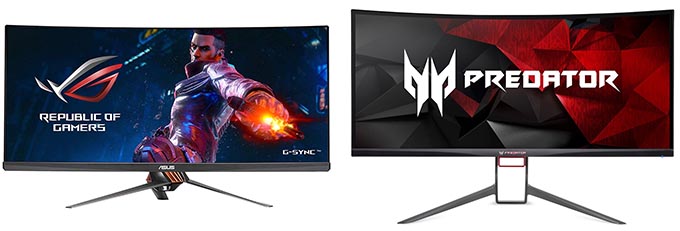
ASUS ROG Swift PG348Q vs Acer Predator X34(P)
These 34″ ultrawides represent some of the best displays ASUS and Acer have to offer.
After making the switch to ultrawide, I don’t plan to go back.
Games are more immersive. Multiple productivity apps will fit side by side with no bezel in the way as with dual widescreens.
Let’s look into the differences in these monitors.
Features
It’s important to know that Acer has two different versions of the X34.
I wish they had given them completely different names, but this is what we got. The X34 Bmiphz is the older version. It can be overclocked to 100Hz, while 60Hz is the native refresh rate.
The X34 Bmiphz has a 3800R curve radius, so the curve is not very pronounced.
Acer updated their lineup with the X34 Pbmiphzx, a.k.a. the X34P.
The original X34 (non-P) uses the same panel as the ASUS PG348Q.
The X34P has an improved panel, also found in the Alienware AW3418DW.
This screen does 100Hz native and 120Hz overclocked. The curve is deeper at 1900R. The on-screen display was improved for the X34P as well.
Since the original X34 is no longer being produced, I’ll focus on the X34P.
Both the ASUS and Acer monitors are 34″, 3440x1440p, IPS panels with G-Sync modules.
The menus on both models are well laid out and offer a good range of adjustment. Ports are identical with DisplayPort, HDMI, and 4-port USB 3.0 hubs.
If you’ll be using the monitor mainly for games, the 120Hz refresh rate and more immersive 1900R curve of the X34P will make it a better choice.
The X34P also has better built-in speakers and a headphone hanger on the back.
Performance
The newer panel in the X34P eliminates the IPS glow that some owners experienced with the PG348Q and original X34.
Brightness, contrast, and color are excellent on both the ASUS and Acer. These are some of the best performing ultrawides out there.
Input lag is a bit lower the X34P, again putting it in favor for games.
Value
Both ASUS and Acer include 3-year warranties.
As of this writing, pricing is very similar between the PG348Q and X34P.
Given the differences in refresh rate and input lag, I think the choice between the older ASUS and updated Acer is a no-brainer.
Overall Winner: Acer X34P
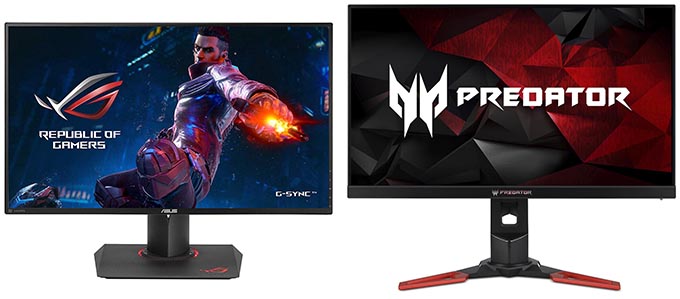
ASUS ROG Swift PG279Q vs Acer Predator XB271HU
These 1440p, high-refresh rate monitors are an excellent choice for FPS and other fast-paced games.
The PG279Q and XB271HU use panels which are nearly identical, so I’ll explain some of the minor differences between these monitors.
Features
Both models have a 27″ 2560×1440 IPS panel, 144Hz native / 165Hz overclocked refresh rate, and G-Sync modules.
Response time and input lag for these monitors are some of the lowest of any monitor. Combined with the high refresh rates and resolution, they’re outstanding for higher-end PC gaming.
Similar ports can be found on the ASUS and Acer. Both have DisplayPort and HDMI. The ASUS has a 2-port USB 3.0 hub while the Acer’s hub is 4-port.
Speakers are included on both, but they’re pretty weak. I wouldn’t plan on using them for games, music, or movies.
The PG279Q has a small bezel all around. The XB271HU has an extra-thin bezel on the top and sides, with a thicker bottom bezel.
The design of the ASUS is pretty well suited to any use, while the Acer goes for more of a gamer aesthetic.
ASUS has the better on-screen display of the two. The top menu bar shows the resolution, refresh rate, and display mode at all times. Acer’s requires some digging around through menus to get to this info. The Acer menu is just not quite as well laid out, though the options are very similar.
Performance
Using such similar panels made by AUOptronics, performance is nearly identical between the PG279Q and XB271HU.
Viewing angles, color, brightness, response time, and input lag are all excellent on these monitors.
If there’s any weakness, it’s the contrast. It’s not bad, but as with other IPS monitors it won’t match the black levels of TFT or VA panels. Most people find the better colors and viewing angles of IPS outweigh this downside.
Value
As we often see with Acer monitors, the price is very competitive. Typically, the XB271HU is available at a price around 10% less than the PG279Q.
Both are great choices, but if you’re already at the top of your budget, the Acer may just be the way to go.
Overall Winner: Acer XB271HU
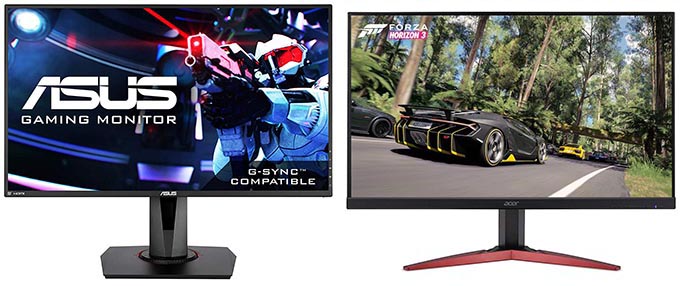
ASUS VG278Q vs Acer KG271 Cbmidpx
If you don’t have $500+ to drop on a video card and $600+ for a monitor, a high-refresh rate 1080p display is a great way to go for a gaming PC.
These monitors offer fast performance for well under $300.
Features
First, Acer has a couple different versions of the KG271. The KG271 Cbmidpx is a 144Hz display that competes with the VG278Q. The KG271 bmiix (aka KG1), which I won’t compare here, is limited to 75Hz.
Both displays use very similar TN panels. They each offer AMD’s FreeSync adaptive sync. They’re also tested as “G-Sync Compatible” monitors.
Ports are identical, with one each of DisplayPort, HDMI, and DVI.
Speakers are included on both, but the sound quality won’t come close to standalone speakers or headphones.
The VG278Q includes an Extreme Low Motion Blur (ELMB) mode. Going to play fast-paced games such as first-person shooters? Consider this feature if you can maintain the setting’s required 120Hz or 144Hz fps frame rates. This reduces blur somewhat during quick movements.
Another point goes to the VG278Q for including a height-adjustable & rotating stand. The KG271 is fixed in height and cannot swivel. Unless you’ll be using a monitor arm, this is a definite drawback.
As with other models, the better menu layout on the ASUS and optional DisplayWidget software put the VG278Q ahead in usability.
Performance
The VG278Q and KG271 perform nearly the same, which is expected given the similarity of their panels.
Input lag is minimal and response time is very fast. Both models are very well suited for competitive gaming.
Being TN monitors, the viewing angles and colors can’t compete with IPS, but they’re as good as expected.
Value
By going with TN rather than IPS panels, the cost of both monitors is kept down. The lack of a hardware G-Sync module offers significant savings, even though these displays are G-Sync compatible.
I personally wouldn’t step down from these 27″ monitors to a 24″ 144hz display from either brand. The VG248QE only costs slightly less but doesn’t offer adaptive sync, and the performance isn’t as good. Acer’s GN246HL and XFA240 are cheaper, but they have poorer visual quality.
The VG278Q typically costs about $25 more than the KG271. It’s still well below $300, which I think is a good value for the performance.
The VG278Q’s ELMB mode, adjustable stand, better on screen display, and optional software justify the small bump in price.
Overall Winner: ASUS VG278Q
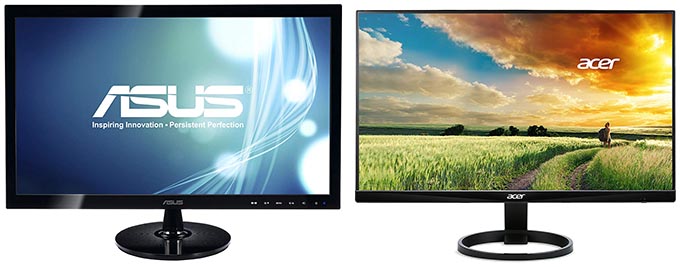
ASUS VS248H-P vs Acer R240HY
Looking for a good quality 24″ monitor, but need to keep the price low?
These two monitors sell in the low $100 range and offer a lot for the money. Let’s see which is the better choice
Features
The biggest difference between these ASUS and Acer models is the type of panel used for the display. The Acer uses IPS while the ASUS is TFT.
In most measures, IPS is superior. Viewing angles are better and colors are more accurate.
If you intend to do photo work or view the screen at an angle, the R240HY is the only way to go. For everyone else, the Acer will still have the nicer looking display.
Both monitors have the same connections: HDMI, DVI, and VGA.
The resolution is 1080p (1920×1080) with a 60Hz refresh rate. This is fine for desktop tasks and slower-paced games, but for fast-paced games you’ll want to look for a monitor with at least a 100Hz refresh rate instead.
Neither monitor has a height adjustable stand, which is typical at this price point. Only tilt adjustment is possible.
The RH240HY has a very slim bezel around the top and sides, which gives it a more modern and higher-end look over the ASUS.
Performance
Response time is a bit better on the VS248H-P. This means motion blur is a bit reduced versus the Acer in fast moving games and movies. Again, keep in mind that a monitor with higher refresh rate is best if clarity and smoothness during fast-paced motion is important.
The color and viewing angles look better on the R240HY. For web browsing, Microsoft Office apps, Adobe software, and other desktop apps the Acer will be the better choice.
Value
The Acer is typically priced at $10-20 less than the ASUS, putting it just over $100. This is an excellent price for an IPS monitor.
The VS248H-P is priced fairly, but given the inferior TFT display, the R240HY is a much better value.
Overall Winner: Acer R240HY
Conclusion
So, which brand is the better choice, ASUS or Acer?
If value is your #1 factor, go with Acer.
The money you save might allow you to bump up from 1080p to 1440p, or from 60Hz to 144Hz. Those differences will have a bigger impact than any differences you see brand to brand.
Do similar monitors from both brands fit you budget?
ASUS monitors have the better on screen display, software, and design.
If their monitors fit your budget, ASUS delivers on quality in all aspects.

